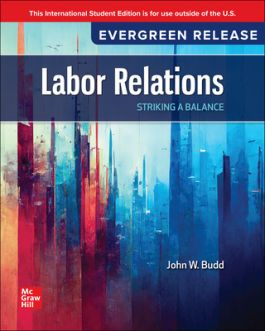Labor Relations: Striking a Balance: 2025 Release ISE
1265071608
·
9781265071608
Budd presents labor relations as a system for balancing employment relationship goals (efficiency, equity, and voice) and the rights of labor and management. By weaving these themes with the importance of alternative perspectives on the nature of emp…
Read More
PART ONE: FOUNDATIONS
1. Contemporary Labor Relations: Objectives, Practices, and
Challenges
2. Labor Unions: Good or Bad?
PART TWO: THE U.S. NEW DEAL INDUSTRIAL RELATIONS
SYSTEM
3. Historical Development
4. Labor Law
5. Labor and Management: Strategies, Structures, and
Constraints
6. Union Organizing
7. Bargaining
8. Impasses, Strikes, and Dispute Resolution
9. Contract Clauses and Their Administration
PART THREE: MAJOR CHALLENGES
10. The Evolving Nature of Work
11. Globalization and Financialization
PART FOUR: REFLECTION
12. Comparative Labor Relations
13. What Should Labor Relations Do?
1. Contemporary Labor Relations: Objectives, Practices, and
Challenges
2. Labor Unions: Good or Bad?
PART TWO: THE U.S. NEW DEAL INDUSTRIAL RELATIONS
SYSTEM
3. Historical Development
4. Labor Law
5. Labor and Management: Strategies, Structures, and
Constraints
6. Union Organizing
7. Bargaining
8. Impasses, Strikes, and Dispute Resolution
9. Contract Clauses and Their Administration
PART THREE: MAJOR CHALLENGES
10. The Evolving Nature of Work
11. Globalization and Financialization
PART FOUR: REFLECTION
12. Comparative Labor Relations
13. What Should Labor Relations Do?
Budd presents labor relations as a system for balancing employment relationship goals (efficiency, equity, and voice) and the rights of labor and management. By weaving these themes with the importance of alternative perspectives on the nature of employment relationship throughout the text, students can learn not only how the traditional labor relations processes work, but also why these processes exist and how to evaluate whether theyare working. In this way, students can develop a deeper understanding of labor relations that will help them successfully navigate a contemporary labor relations system that faces severe pressures requiring new strategies, policies, and practices.

